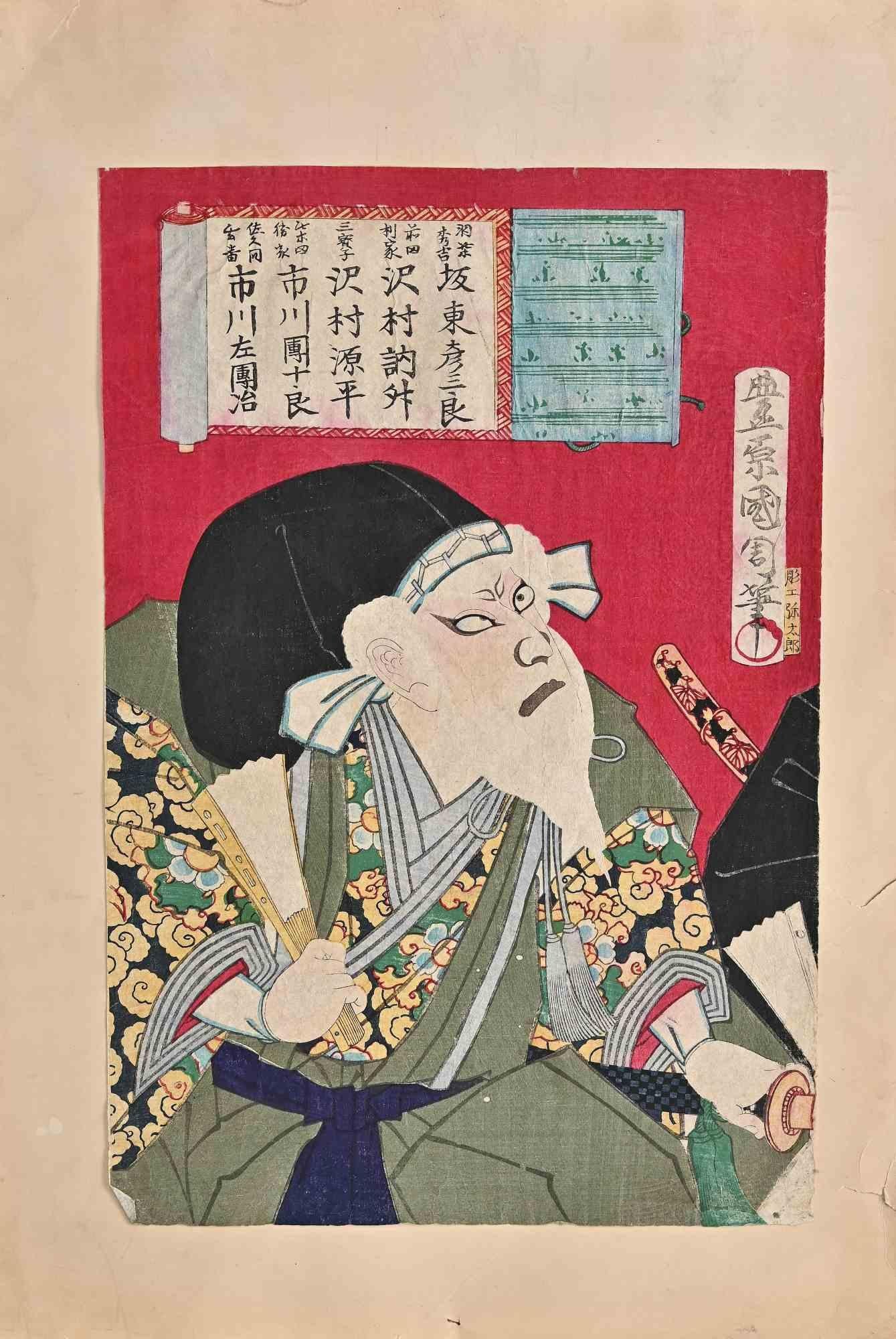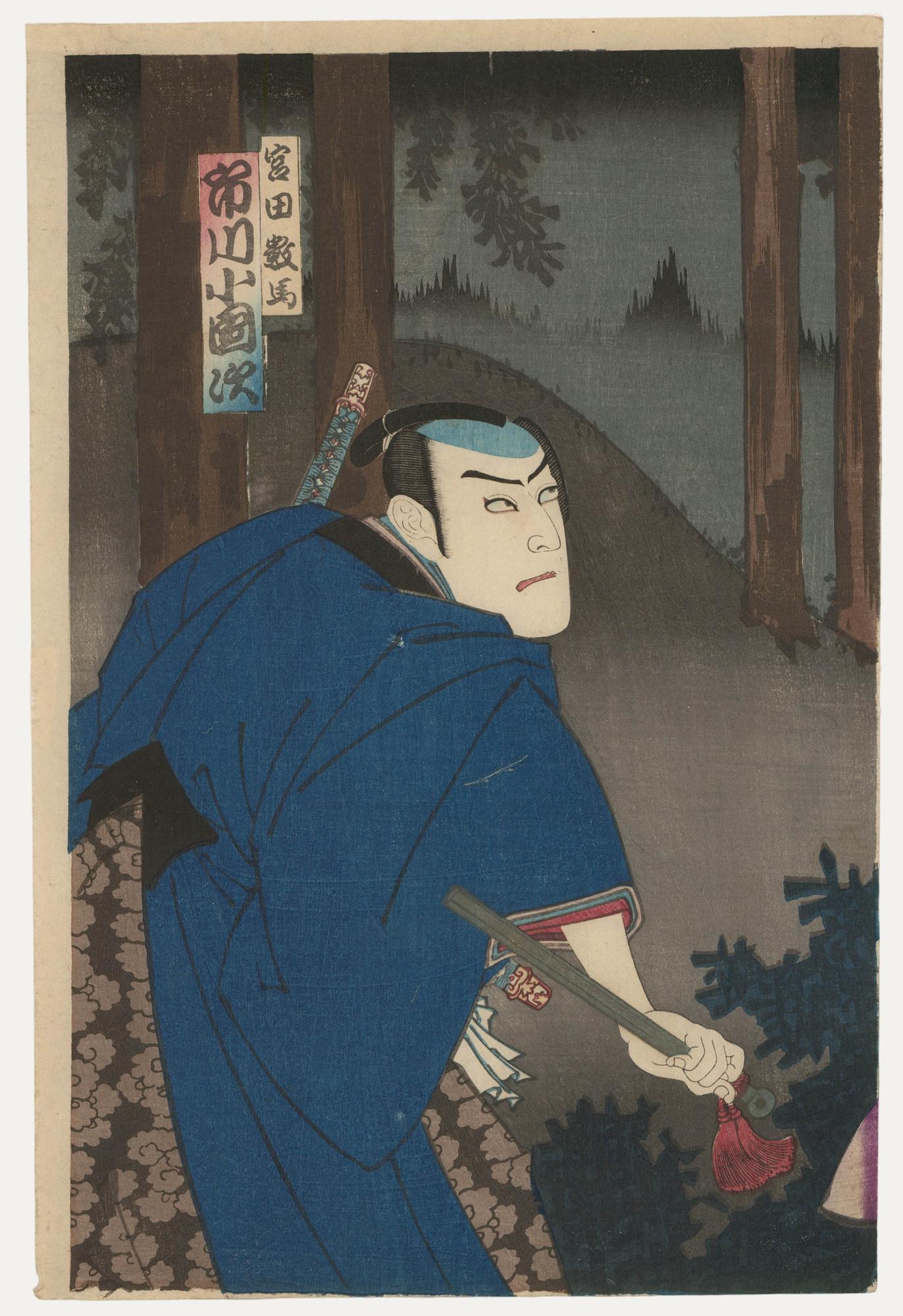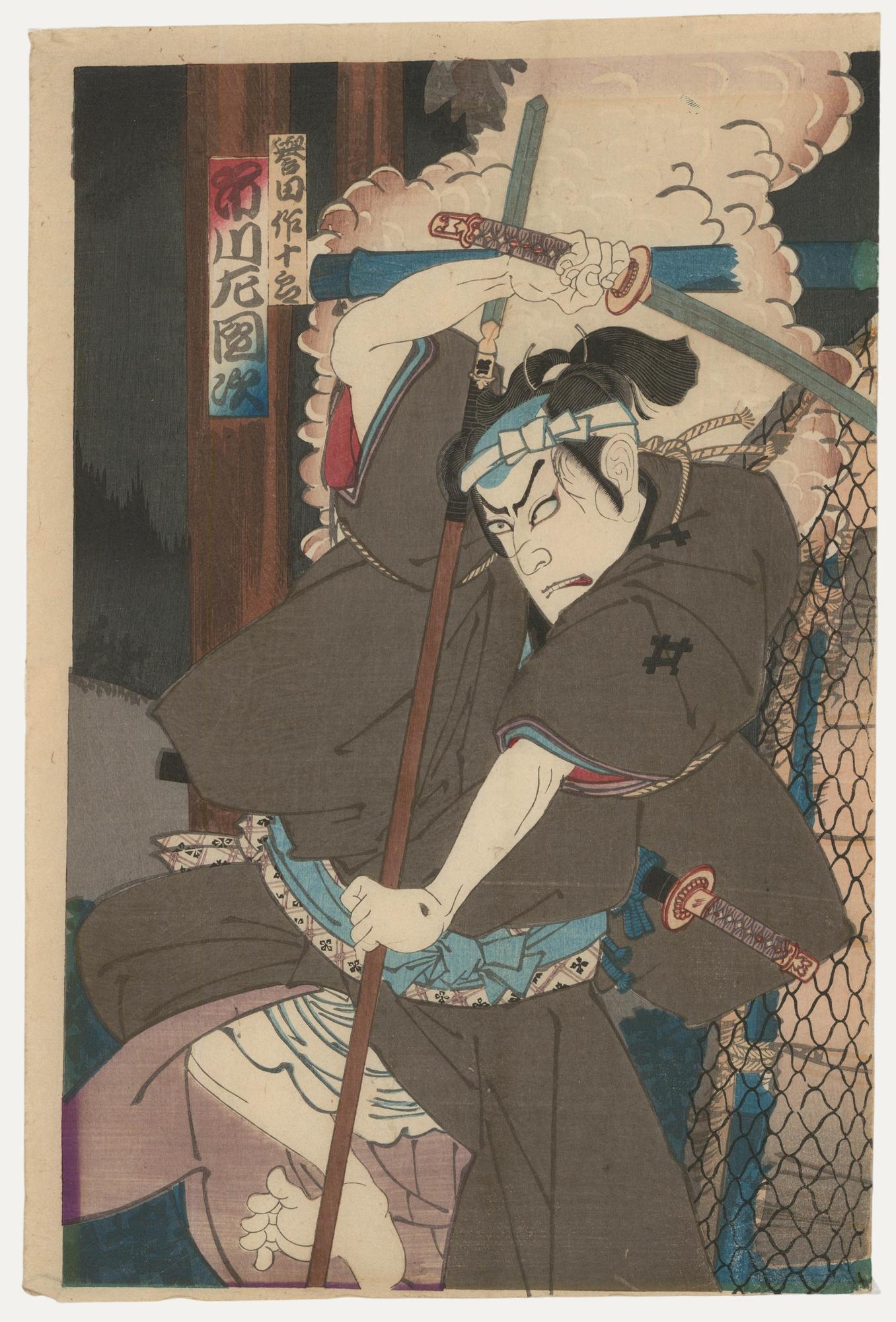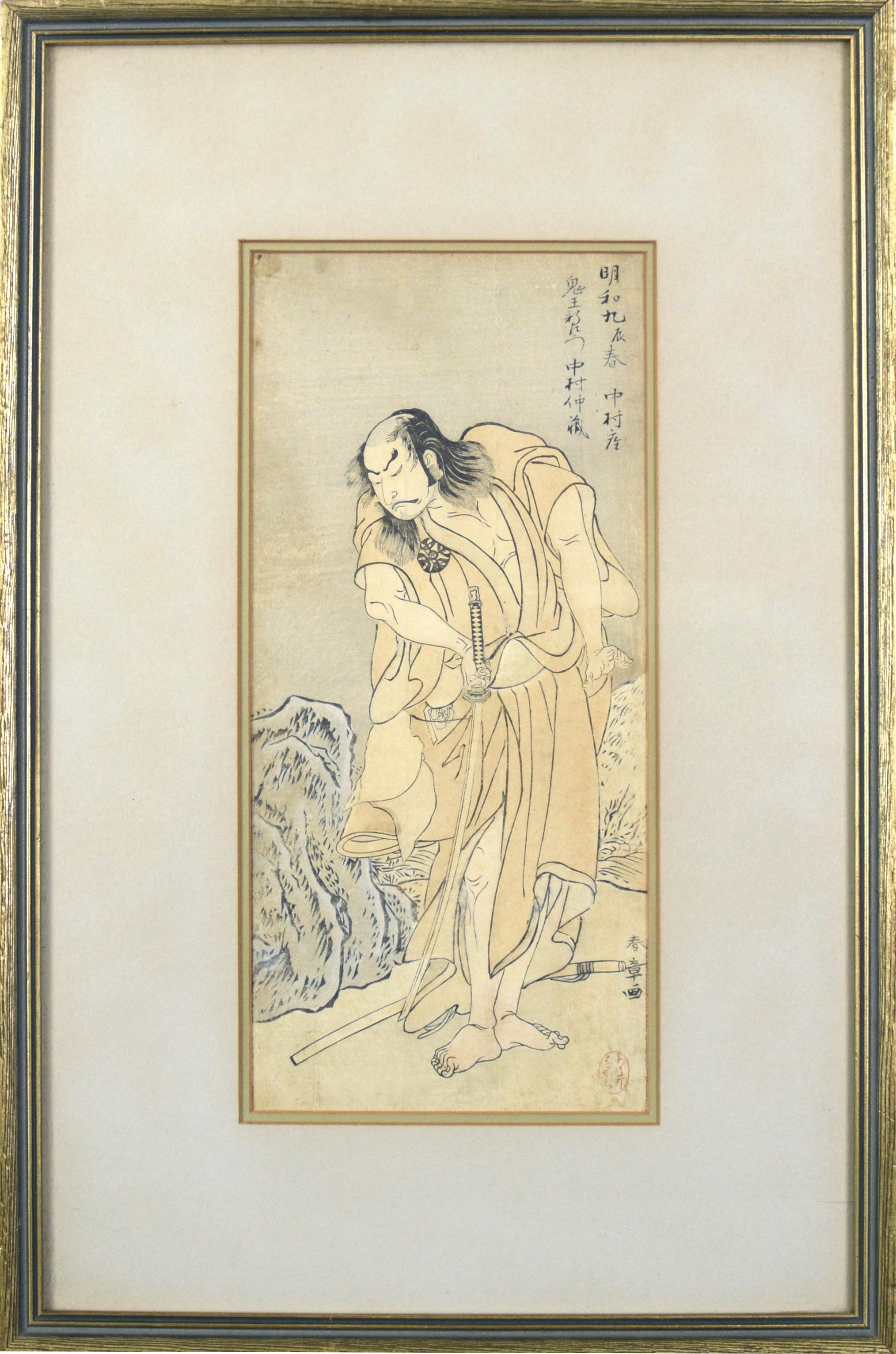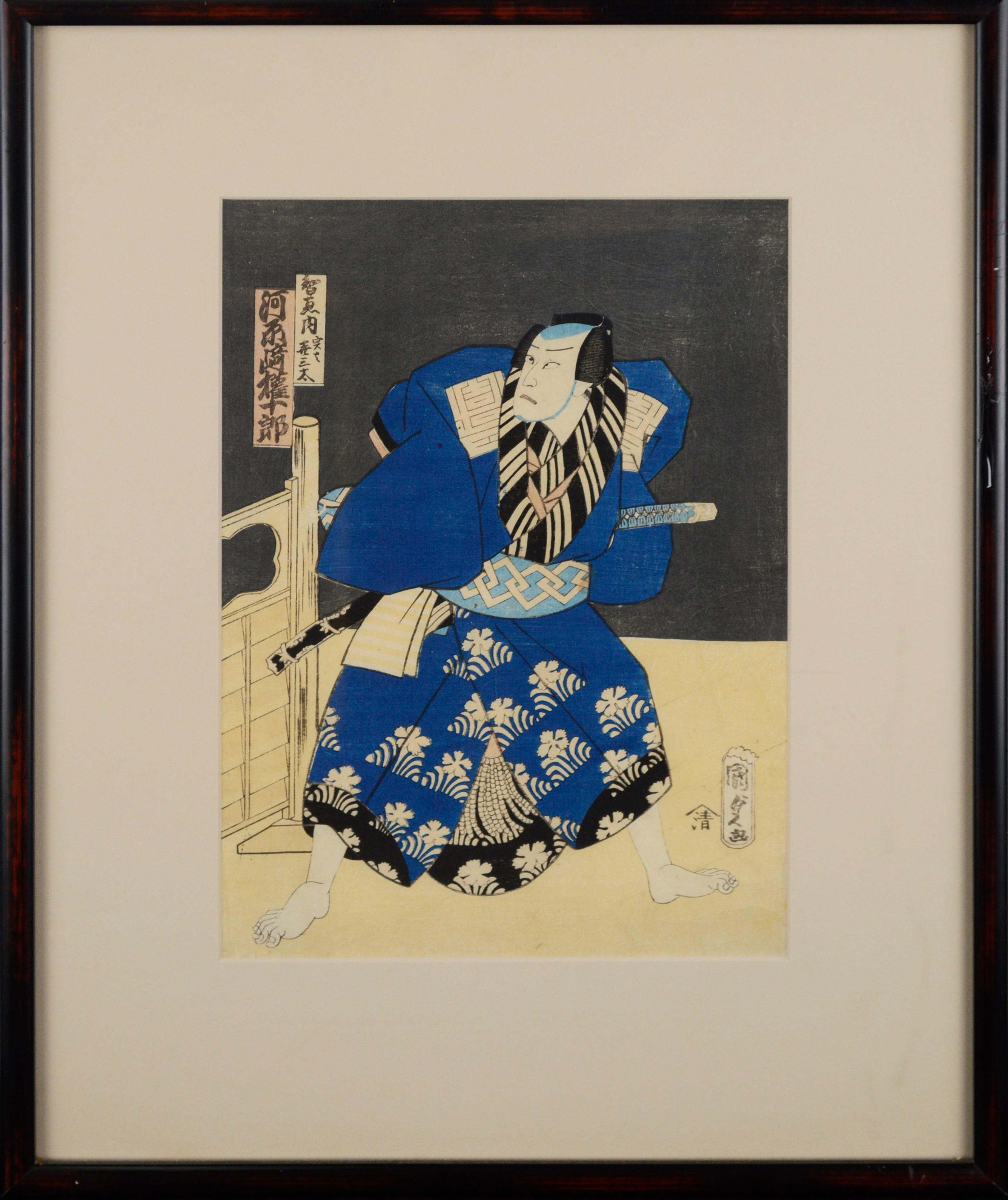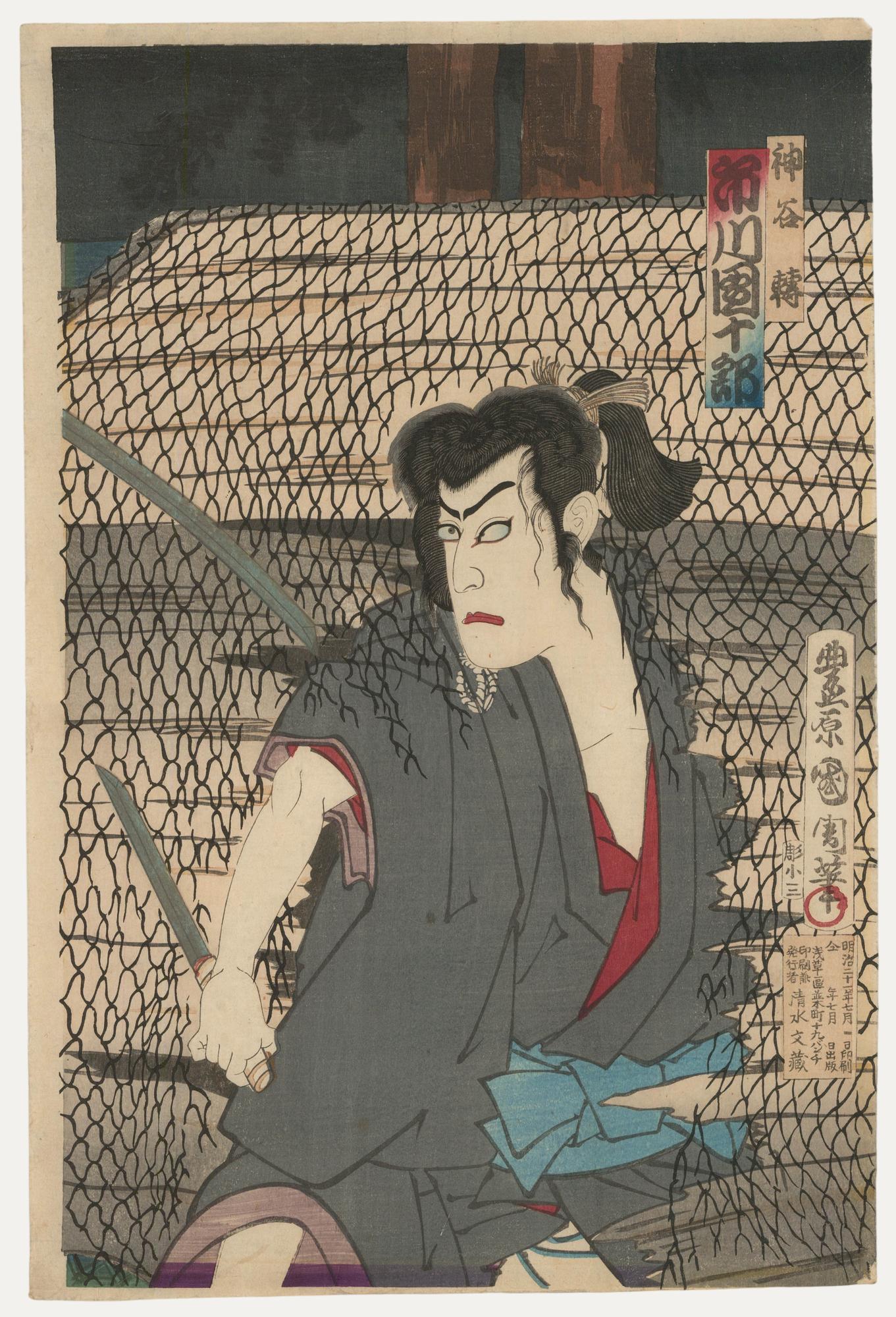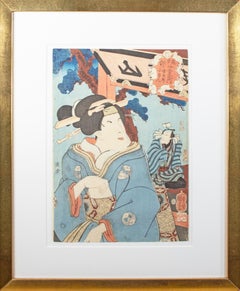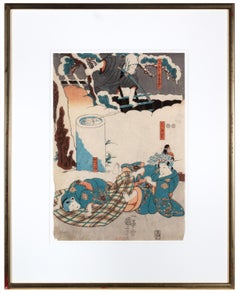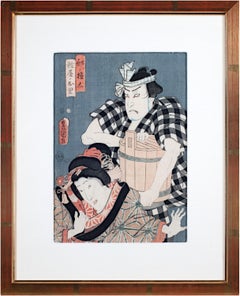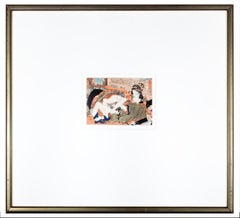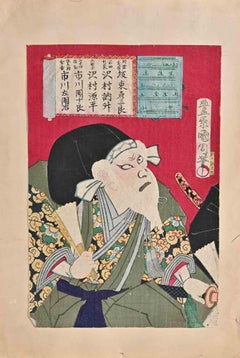Items Similar to 19th century color woodcut Japanese ukiyo-e print samurai figure
Want more images or videos?
Request additional images or videos from the seller
1 of 8
Toyoharu Kunichika19th century color woodcut Japanese ukiyo-e print samurai figure1862
1862
$3,000
£2,299.88
€2,631.71
CA$4,239.68
A$4,608.36
CHF 2,466.93
MX$55,704.39
NOK 31,088.12
SEK 28,671.32
DKK 19,654.67
About the Item
"Ichimura Hazaemon as Hatsuyumeya Mitsujiro" is a woodcut print by Toyoharu Kunichika in red, blue, and black.
14" x 9 1/2" art
20 3/4" x 16 3/4" framed
From the series “First Performance of the Year in the Misty Spring of Plub Blossoms” (Ume no Haru Kasumi no Hikizome). This print depicts Ichimura Uzaemon XIII as Hatsuyumeya Kojiro. The publisher of this series was Tsujiokaya Bunsuke, and the Boston Museum of Fine Arts also holds the same print as part of the William Sturgis Bigelow Collection. The actor depicted here, Ichimura Uzaemon XIII, went on to take the name Onoe Kikugoro V and became known as one of the three most famous Kabuki actors of the Meiji era, alongside Ichikawa Danjuro IX and Ichikawa Sadanji I. Kikugoro V was known for performing both male and female roles, whereas most kabuki actors specialize in one or the other. Strongly devoted to his craft, Kikugoro V went as far as to visit the battlefield during the Battle of Ueno in 1868 so as to study what soldiers and war was really like, hoping to better his portrayal on stage. He also had the chance to perform for Ulysses S. Grant in 1879 in a play that symbolically connected the American Civil War with the 11th century Japanese Gosannen War. Kikugoro V was one of the two actors in the earliest known Japanese film Momijigari, portraying the Demon Princess who terrorizes a Buddhist monk before being disposed of by the traveling swordsman played by Ichikawa Danjuro IX. Unlike Danjuro IX, Kikugoro V is said to have been supportive of the movie process, and was instrumental in convincing the more reluctant Danjuro IX to do the film.
About the Seller
4.9
Gold Seller
Premium sellers maintaining a 4.3+ rating and 24-hour response times
Established in 1966
1stDibs seller since 2017
453 sales on 1stDibs
Typical response time: 1 hour
- ShippingRetrieving quote...Shipping from: Milwaukee, WI
- Return Policy
More From This Seller
View All19th century color woodcut Japanese ukiyo-e print female geisha figure signed
By Utagawa Kuniyoshi
Located in Milwaukee, WI
This print is from a highly regarded series by the Edo woodblock artist Utagawa Kuniyoshi: in the period, there were at times prohibitions in depicting a...
Category
1850s Edo Figurative Prints
Materials
Pigment, Paper, Woodcut
"Tokijiro, Midori, and Katsumi, " a Color Woodcut
By Kuniyoshi
Located in Milwaukee, WI
"Tokijiro, Midori, and Katsumi" is an original Japanese color woodcut by the artist Kuniyoshi. It was created in 1851 and depicts a scene from the play "Akegarasu Hana no Nureginu" (...
Category
1850s Figurative Prints
Materials
Woodcut
"Gonta and Osato, Walking Beauty in Winter Eve, " Japanese Color Woodcut
By Utagawa Toyokuni II
Located in Milwaukee, WI
This woodblock print depicts two characters from the play Godairiki Koi no Fujime, Igami no Gonda and Koman, a Geisha. The play tells the story of Koman, who is in love with the nob...
Category
1850s Figurative Prints
Materials
Woodcut
'Courtesan and Young Man at Fuchu' Original Erotic Shunga Woodblock
By Utagawa Hiroshige (Ando Hiroshige)
Located in Milwaukee, WI
The present work is an excellent example of the erotic Shunga prints produced by Utagawa 'Ando' Hioshige and his school. Shunga imagery became especially widespread in Japan with the...
Category
Mid-19th Century Edo Figurative Prints
Materials
Woodcut
"Yanagibashi in Snow, " Color Woodcut Portrait with Umbrella
By Utagawa Kunisada (Toyokuni III)
Located in Milwaukee, WI
"Yanagibashi in Snow" is an original color woodcut by Utagawa Kunisada. This woodblock print depicts a woman walking in the snow near the Motoyanagi canal, which was located in Tokyo...
Category
1920s Figurative Prints
Materials
Woodcut
'Lovers of Okazaki' Original Erotic Shunga Woodblock Print by Utagawa Hiroshige
By Utagawa Hiroshige (Ando Hiroshige)
Located in Milwaukee, WI
The present work is an excellent example of the erotic Shunga prints produced by Utagawa 'Ando' Hioshige and his school. Shunga imagery became especially widespread in Japan with the...
Category
Mid-19th Century Edo Figurative Prints
Materials
Woodcut
You May Also Like
Old Samurai - Woodcut Print after Utagawa Kunisada - Late 19th Century
By Utagawa Kunisada (Toyokuni III)
Located in Roma, IT
Old Samurai is a Woodcut print realized in late 19 century after Utagawa Kunisada.
Good condition and Beautiful colored woodblock print, included a cardboard passpartout (46x32 cm...
Category
Late 19th Century Modern Figurative Prints
Materials
Woodcut
Toyohara Kunichika (1835-1900) - Japanese Woodblock, Kabuki Samurai III
By Toyohara Kunichika
Located in Corsham, GB
An evocative late 19th century Japanese woodblock by the master artist Toyohara Kunichika (1835-1900), depicting a Kabuki actor in the dramatic role of a fierce samurai. The composit...
Category
Late 19th Century Figurative Prints
Materials
Woodcut
Toyohara Kunichika (1835-1900) - Japanese Woodblock, Kabuki Samurai II
By Toyohara Kunichika
Located in Corsham, GB
An evocative late 19th century Japanese woodblock by the master artist Toyohara Kunichika (1835-1900), depicting a Kabuki actor in the dramatic role of a fierce samurai. The composit...
Category
Late 19th Century Figurative Prints
Materials
Woodcut
Actor as Samurai - 18th Century Japanese Woodblock Print
By Katsukawa Shunshō
Located in Soquel, CA
Actor as Samurai - 18th Century Japanese Woodblock Print
Woodblock print depicting an actor, possibly Nakamura Denkuro II, as a samurai. The actor stands with his sword unsheathed a...
Category
Late 18th Century Edo Figurative Prints
Materials
Woodcut, Rice Paper
Kabuki Actor, Mid 19th Century Figurative Japanese Woodblock Print
By Utagawa Kunisada (Toyokuni III)
Located in Soquel, CA
Beautiful mid 19th century figural Japanese woodblock print of a kabuki actor in blue by Utagawa Toyokuni III (Kunisada) (Japanese, 1786-1864/5). Artist's chop is in the upper left corner of the piece. Presented in a cream mat, with a black and red frame and plexiglas. Image size ~13.5"H x 9.5"W
During his lifetime Kunisada Utagawa...
Category
1860s Edo Figurative Prints
Materials
Paper, Ink
Toyohara Kunichika (1835-1900) - Japanese Woodblock, Kabuki Samurai I
By Toyohara Kunichika
Located in Corsham, GB
An evocative late 19th century Japanese woodblock by the master artist Toyohara Kunichika (1835-1900), depicting a Kabuki actor in the dramatic role of a fierce samurai. The composit...
Category
Late 19th Century Figurative Prints
Materials
Woodcut
More Ways To Browse
American Civil War
11th Century
Japan Samurai
Japanese Samurai Art
Ulysses S Grant
Ukiyo Samurai
Linogravure Picasso
Luis Salazar
M Utrillo
Mabel Royds Woodcut
Magritte Etching
Magritte Le Retour
Mandela Hand Prints
Marc Chagall Carmen
Marc Chagall Etchings Signed
Marc Chagall Green Horse
Marc Chagall Lithos
Marc Chagall Pencil Signed
